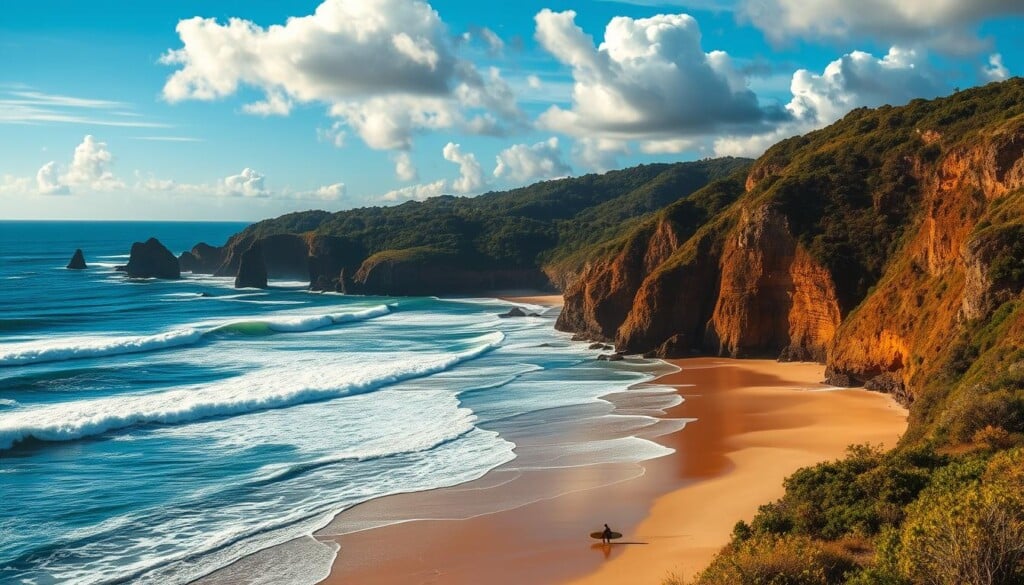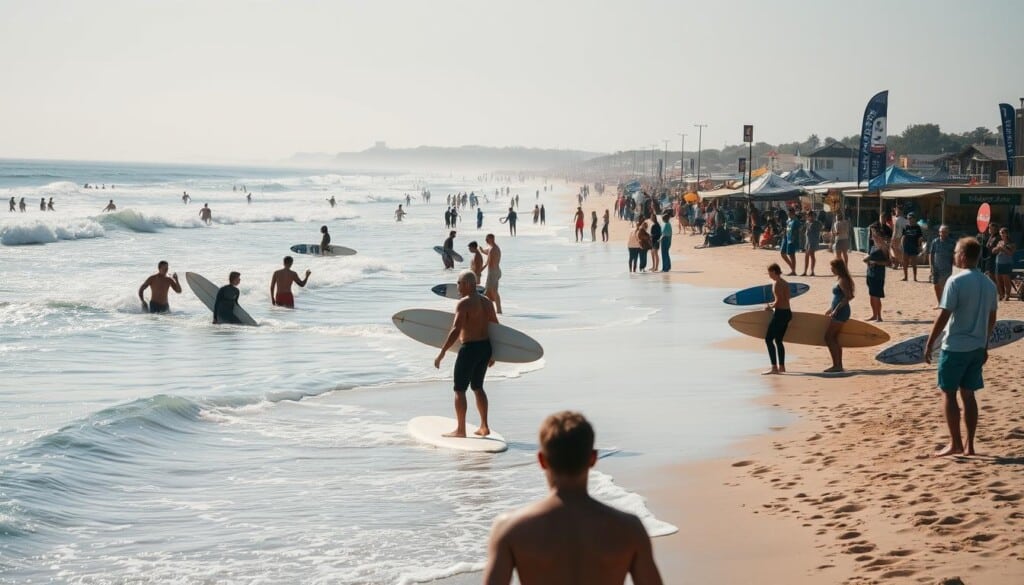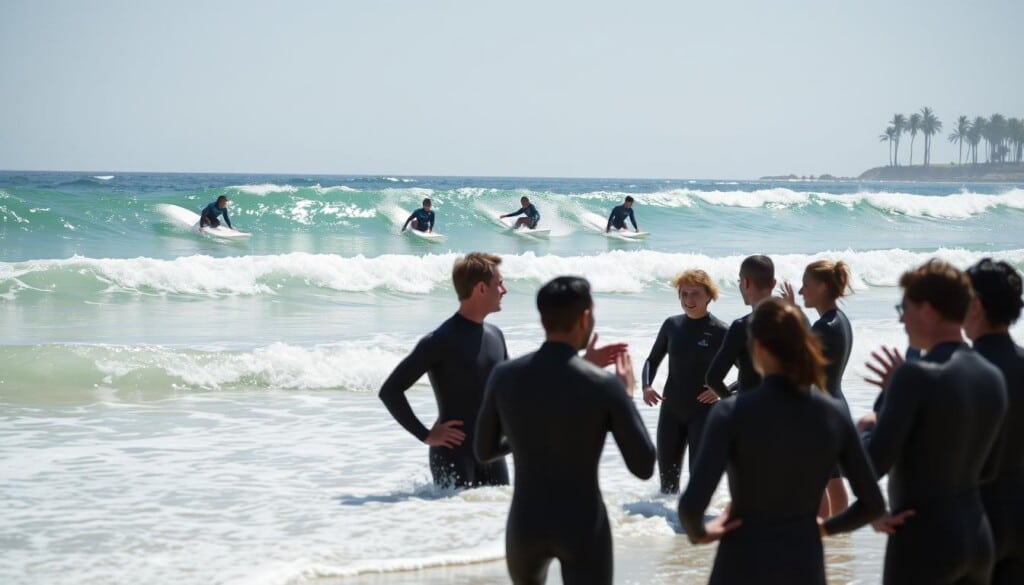Are you ready to dive into the world of surfing? Not sure where to start or how to get better? This article has essential tips for both new and experienced surfers. It aims to boost their skills in the lively surf culture.
Learning basic techniques and safety measures can make your time in the water better. We’ll also cover important topics like reading surf conditions and advanced techniques. This way, you can catch waves with confidence and skill.
Key Takeaways
- Essential surfing tips are key for both beginners and seasoned surfers.
- Safety measures and understanding surf conditions are vital for successful surfing.
- Mastering basic techniques prepares surfers for advanced techniques.
- Catching waves confidently makes surfing more enjoyable.
- Knowing local surfing spots can improve your experience.
Understanding the Basics of Surfing
Learning the basics of surfing is key. You need to know about surfboard anatomy, surfing terms, and staying safe. This knowledge helps you surf better and enjoy it more.
The Anatomy of a Surfboard
A surfboard has parts that affect how it rides. The nose is the front, and the tail is the back. These shapes help with control.
The rails, or edges, are important for turning. The bottom shape affects how the board moves through water. Fins help with stability and steering.
Surfboards are made from foam, fiberglass, and epoxy. These materials affect the board’s weight, how it floats, and how long it lasts.
Key Surfing Terminologies
Knowing surfing terms helps you talk with other surfers. Terms like “drop-in” and “takeoff” are important. They help you understand how to surf.
Terms like “cutback” and “lip” are also key. They help you know how to move on the wave and avoid the wave’s edge.
The Importance of Safety
Safety is always first in surfing. Knowing your surroundings is key. Staying away from the impact zone can prevent injuries.
Handling your board right and knowing water hazards are also important. Understanding rip currents is critical. It helps keep you safe while surfing.
Choosing the Right Surfboard
Choosing a surfboard can be tough, with so many options out there. Knowing the different types of surfboards helps make this choice easier. Each type is best for certain conditions and skill levels.
Types of Surfboards Explained
Longboards are great for beginners because they are stable and easy to paddle. Shortboards are better for advanced surfers who need agility in bigger waves. Funboards are a mix, good for all skill levels and wave sizes.
Fish surfboards are short and wide, perfect for small waves. They make quick turns easy. Knowing these types helps you pick the right board for your skill and style.
Factors to Consider When Selecting a Board
Several things affect how a surfboard performs. Volume is key for buoyancy, helping with paddling and staying stable. The rocker profile, or curve, of the board impacts its wave ride. A flatter rocker is faster, while a more curved rocker is better for turns.
The length of the board also matters. It depends on your weight and skill level. Choosing a board that fits your surfing goals makes for a better experience.
Finding the Best Surfing Spots in the U.S.
Surfing in the United States is a thrilling adventure. It offers a wide range of experiences. From California’s golden beaches to Hawaii’s legendary waves, each state has its own unique spots.
Understanding these areas helps surfers connect with local surf communities. This connection makes their surfing experience even better.
Top Surfing Destinations to Explore
California is a favorite among wave lovers. It’s known for places like Malibu and Huntington Beach. The waves are strong, and the weather is warm, making it perfect for surfing all year.
Hawaii is where surfing was born. It’s famous for spots like Waimea Bay and Pipeline. These places offer thrilling waves and stunning beauty.
Florida is great for beginners. Places like Cocoa Beach have gentle waves. They’re perfect for those just starting out.
Local Surfing Communities
Getting involved with local surf communities is key. They offer tips to improve your skills. They also help you find surfing buddies, no matter your level.
Many communities hold events and sessions. These help build friendships among surfers. Being part of a local surf community makes learning and growing in the sport more enjoyable.

Essential Surfing Gear for Beginners
Starting to surf means you need the right gear for comfort and safety. Wetsuits are key, along with leashes and wax. Knowing what to pick can greatly improve your experience.
Wetsuits: When and Why You Need Them
A wetsuit keeps you warm in cold water. The thickness depends on the water temperature. For example, a 3/2 mm wetsuit works for 60-65°F water, and a 4/3 mm suit is better for colder water.
Other Gear: Leashes, Wax, and More
Leashes are important for safety, keeping your board close after a fall. Wax helps you grip your board, which is key for control. Don’t forget rash guards and reef-safe sunscreen for UV protection and skin safety.
Mastering the Fundamentals of Surfing
Learning the basics of surfing is key for anyone wanting to get better. This part covers important paddling techniques and how to pop up on the board. Both are critical for a good surf takeoff.
Paddling Techniques for Success
Good paddling techniques can really boost your performance in the water. Keeping your body in the right position helps you move faster and more efficiently. This means less drag and more power.
When paddling, keep your hips low and your head steady. This makes you more streamlined in the water. Timing is also important, as it helps you catch the wave at the right moment. Knowing when to paddle hard is essential for a smooth surf takeoff.
How to Pop Up on Your Board
Knowing how to pop up on the board is vital for moving from paddling to standing. This skill changes based on your level and the waves you’re surfing. A quick and smooth pop-up helps you balance better and ride the wave more effectively.
Starters might take it slower, focusing on timing. More experienced surfers can move faster to handle different conditions. Being able to adapt is key to mastering surf basics and riding waves with confidence.
Surfing Etiquette and Local Culture
Knowing surfing etiquette is key for all surfers. It makes sure everyone has a good time in the water. When waves are busy, it’s important to take turns.
Following the drop-in rule helps keep things fair. It shows respect for everyone in the surfing world.
Respecting Other Surfers and Their Space
It’s important to keep a safe distance while waiting for waves. This lets everyone surf without trouble. Beginners can learn a lot by watching how experienced surfers act.
Understanding Local Conditions
Knowing the local surf spot’s conditions is essential. This includes tide patterns and how waves behave. Talking to local surfers can teach you a lot.
By understanding local conditions, you can surf better and safely. It’s a way to improve your skills while respecting the surfing community.

Advanced Surfing Techniques
Learning to surf means moving to advanced techniques. These help you tackle bigger waves and show off your skills. You’ll need to learn strategies for handling tough surf and doing cool tricks. Here are key points for riding bigger waves and doing surf tricks.
Tips for Riding Bigger Waves
To ride bigger waves, you need to be mentally ready, have the right board, and know the ocean. Where you position yourself is key. Being in the right spot can greatly improve your ride.
Timing is everything. You must paddle at the exact right moment to catch the wave. Always wear safety gear and choose the right board for stability and control. With time, you’ll get better at reading the waves and making quick moves.
Tricks and Maneuvers to Impress
Advanced surfing is not just about staying on the board. It’s about doing cool tricks. Tricks like cutbacks and aerials need practice and skill. They make your surfing stand out.
Doing tube rides is thrilling. You ride through the wave’s hollow part. Mastering these tricks makes your surfing better and more fun.
Understanding Surf Conditions
Surf conditions are key to a great surfing session. Learning to read waves helps surfers find the best spots and times. Swell direction and tide levels change wave size and shape, giving different surfing experiences.
Good wave reading comes from watching the ocean closely and practicing. This skill lets surfers pick the best waves to ride.
Reading The Waves
Good wave reading means paying attention to the ocean’s details. Surfers watch how waves change with wind and tides. This helps them know when and where to surf.
Local tips and apps help predict surf conditions. This lets surfers catch the best waves. Using apps for surf reports can make surfing better.
Weather Patterns and Their Impact
Weather greatly affects surfing. Wind, storms, and temperature changes impact waves and the water. Surfers need to know about these to surf on the best days.
Checking forecasts and using apps helps understand wave behavior. Knowing local weather can lead to better surf days. For more info, visit LocalZ.
Surfing Lessons: Why They Matter
Surfing lessons offer many benefits for both new and experienced surfers. It’s important to choose qualified instructors. They provide the knowledge and safety needed for learning.
Students learn not just how to surf but also about the ocean and surf culture. This broadens their understanding and appreciation.
Finding Qualified Instructors
When looking for instructors, focus on those with the right credentials. Look for CPR certification and structured teaching methods. These ensure a safe and educational learning space.
Experienced coaches tailor surf classes to fit each student’s level and needs. This makes the learning experience better and more enjoyable.
What to Expect from Surfing Classes
Surfing classes mix practical skills with safety lessons. Instructors teach key techniques like paddling, popping up, and riding waves. Students get a mix of hands-on practice and theory.
This approach builds confidence and skill in the water. Regular lessons with qualified instructors help improve quickly. It can also spark a lifelong love for surfing.

The Benefits of Joining LocalZ
Joining LocalZ brings many benefits to surfers of all levels. It connects you with local experts who share valuable surfing tips and know the best spots. This platform is a key resource for finding qualified instructors and surf shops that meet your needs.
How LocalZ Connects You to Local Experts
LocalZ makes it easy to connect with local experts. They share insights on surf conditions, gear, and local tips. This helps surfers improve their skills and enjoy the water with confidence.
Supporting Community Through LocalZ
LocalZ supports the community by giving 50% of its fees to local groups. This boosts the local economy and brings businesses and residents together. By joining LocalZ, you not only improve your surfing but also help grow a supportive community.
The Role of Local Businesses in Surfing Culture
Local businesses are key in making surfing culture better. They help connect surfers with their communities. Sites like LocalZ help surf shops share local events, lessons, and gear. This makes surfing fun for everyone, no matter their skill level.
How LocalZ Connects Surfers with Local Experts
LocalZ makes it easy for surfers to find local experts. These experts include instructors and shop owners who know what the community needs. They offer top-notch lessons and gear, making surfing better for all.
Local businesses aim to give each surfer a unique experience. They help both new and experienced surfers grow and learn together.
Supporting Surf Shops and Community Events
Surf shops are the heart of local surfing. They sell products and services and get involved in the community. They host events, workshops, and competitions that bring surfers together.
By supporting these shops, we help surfing culture thrive. This creates unforgettable experiences for everyone involved.
Getting Involved: Surfing Events and Competitions
Getting into surfing events is exciting and can improve your skills. Local competitions let both competitors and fans see amazing talent up close. You can find out about these events at local surf shops or online.
Being part of these events helps you grow as a surfer. It also builds strong bonds with others who love the sport.
Finding Local Surf Competitions
Surfers looking to compete should check out local events all year. These can range from small contests to big competitions. Competing helps you get better by facing off against others.
Experienced surfers can also guide newcomers. This creates a supportive community where everyone learns from each other.
How to Participate or Spectate
To compete, sign up early and know the event rules. On the day, bring your surfboard, wetsuit, and personal items. This makes sure you’re ready to go.
For fans, knowing the schedule and finding a good spot to watch is key. Cheering on competitors and enjoying the vibe makes these events fun for everyone.

